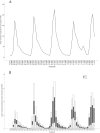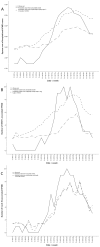Time series analysis of hand-foot-mouth disease hospitalization in Zhengzhou: establishment of forecasting models using climate variables as predictors
- PMID: 24498221
- PMCID: PMC3909295
- DOI: 10.1371/journal.pone.0087916
Time series analysis of hand-foot-mouth disease hospitalization in Zhengzhou: establishment of forecasting models using climate variables as predictors
Abstract
Background: Large-scale outbreaks of hand-foot-mouth disease (HFMD) have occurred frequently and caused neurological sequelae in mainland China since 2008. Prediction of the activity of HFMD epidemics a few weeks ahead is useful in taking preventive measures for efficient HFMD control.
Methods: Samples obtained from children hospitalized with HFMD in Zhengzhou, Henan, China, were examined for the existence of pathogens with reverse-transcriptase polymerase chain reaction (RT-PCR) from 2008 to 2012. Seasonal Autoregressive Integrated Moving Average (SARIMA) models for the weekly number of HFMD, Human enterovirus 71(HEV71) and CoxsackievirusA16 (CoxA16) associated HFMD were developed and validated. Cross correlation between the number of HFMD hospitalizations and climatic variables was computed to identify significant variables to be included as external factors. Time series modeling was carried out using multivariate SARIMA models when there was significant predictor meteorological variable.
Results: 2932 samples from the patients hospitalized with HFMD, 748 were detected with HEV71, 527 with CoxA16 and 787 with other enterovirus (other EV) from January 2008 to June 2012. Average atmospheric temperature (T{avg}) lagged at 2 or 3 weeks were identified as significant predictors for the number of HFMD and the pathogens. SARIMA(0,1,0)(1,0,0)52 associated with T{avg} at lag 2 (T{avg}-Lag 2) weeks, SARIMA(0,1,2)(1,0,0)52 with T{avg}-Lag 2 weeks and SARIMA(0,1,1)(1,1,0)52 with T{avg}-Lag 3 weeks were developed and validated for description and predication the weekly number of HFMD, HEV71-associated HFMD, and Cox A16-associated HFMD hospitalizations.
Conclusion: Seasonal pattern of certain HFMD pathogens can be associated by meteorological factors. The SARIMA model including climatic variables could be used as an early and reliable monitoring system to predict annual HFMD epidemics.
Conflict of interest statement
Figures





References
-
- Ang LW, Koh BK, Chan KP, Chua LT, James L, et al. (2009) Epidemiology and control of hand, foot and mouth disease in Singapore, 2001–2007. Ann Acad Med Singapore 38: 106–112. - PubMed
-
- Chan LG, Parashar UD, Lye MS, Ong FG, Zaki SR, et al. (2000) Deaths of children during an outbreak of hand, foot, and mouth disease in sarawak, malaysia: clinical and pathological characteristics of the disease. For the Outbreak Study Group. Clinical Infectious Diseases 31: 678–683. - PubMed
-
- Fujimoto T, Chikahira M, Yoshida S, Ebira H, Hasegawa A, et al. (2002) Outbreak of central nervous system disease associated with hand, foot, and mouth disease in Japan during the summer of 2000: detection and molecular epidemiology of enterovirus71. Microbiol Immunol 46: 621–627. - PubMed
-
- Chen KT, Chang HL, Wang ST, Cheng YT, Yang JY (2007) Epidemiologic features of hand-foot-mouth disease and herpangina caused by enterovirus71 in Taiwan, 1998–2005. Pediatrics 120: e244–252. - PubMed
Publication types
MeSH terms
LinkOut - more resources
Full Text Sources
Other Literature Sources

